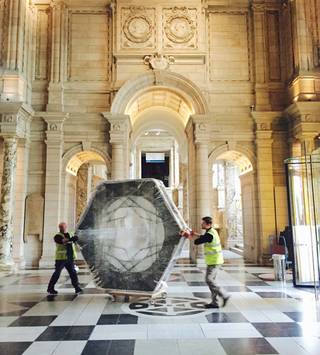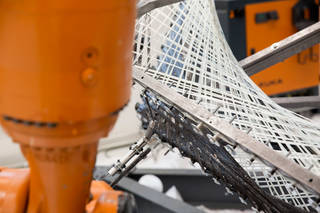The Victoria & Albert Museum (V&A) in London, UK, opened its Engineering Season show on May 18, 2016 (it runs until Nov. 6, 2016) featuring a robot installation and an exhibition putting the spotlight on Ove Arup, “the most significant engineer of the 20th century” according to the V&A’s May ??, 2016 press release,
The first major retrospective of the most influential engineer of the 20th century and a site specific installation inspired by nature and fabricated by robots will be the highlights of the V&A’s first ever Engineering Season, complemented by displays, events and digital initiatives dedicated to global engineering design. The V&A Engineering Season will highlight the importance of engineering in our daily lives and consider engineers as the ‘unsung heroes’ of design, who play a vital and creative role in the creation of our built environment.
Before launching into the robot/biomimicry part of this story, here’s a very brief description of why Ove Arup is considered so significant and influential,
Engineering the World: Ove Arup and the Philosophy of Total Design will explore the work and legacy of Ove Arup (1895-1988), … . Ove pioneered a multidisciplinary approach to design that has defined the way engineering is understood and practiced today. Spanning 100 years of engineering and architectural design, the exhibition will be guided by Ove’s writings about design and include his early projects, such as the Penguin Pool at London Zoo, as well as renowned projects by the firm including Sydney Opera House [Australia] and the Centre Pompidou in Paris. Arup’s collaborations with major architects of the 20th century pioneered new approaches to design and construction that remain influential today, with the firm’s legacy visible in many buildings across London and around the world. It will also showcase recent work by Arup, from major infrastructure projects like Crossrail and novel technologies for acoustics and crowd flow analysis, to engineering solutions for open source housing design.
Robots, biomimicry and the Elytra Filament Pavilion
A May 18, 2016 article by Tim Master for BBC (British Broadcasting Corporation) news online describes the pavilion installation,
A robot has taken up residence at the Victoria & Albert Musuem to construct a new installation at its London gardens.
The robot – which resembles something from a car assembly line – will build new sections of the Elytra Filament Pavilion over the coming months.
The futuristic structure will grow and change shape using data based on how visitors interact with it.
…
Elytra’s canopy is made up of 40 hexagonal cells – made from strips of carbon and glass fibre – which have been tightly wound into shape by the computer-controlled Kuka robot.
Each cell takes about three hours to build. On certain days, visitors to the V&A will be able to watch the robot create new cells that will be added to the canopy.
Here are some images made available by V&A,
Here’s more detail from the V&A’s Elytra Filament Pavilion installation description,
Elytra Filament Pavilion has been created by experimental German architect Achim Menges with Moritz Dörstelmann, structural engineer Jan Knippers and climate engineer Thomas Auer.
Menges and Knippers are leaders of research institutes at the University of Stuttgart that are pioneering the integration of biomimicry, robotic fabrication and new materials research in architecture. This installation emerges from their ongoing research projects and is their first-ever major commission in the UK.
The pavilion explores the impact of emerging robotic technologies on architectural design, engineering and making.
Its design is inspired by lightweight construction principles found in nature, the filament structures of the forewing shells of flying beetles known as elytra. Made of glass and carbon fibre, each component of the undulating canopy is produced using an innovative robotic winding technique developed by the designers. Like beetle elytra, the pavilion’s filament structure is both very strong and very light – spanning over 200m2 it weighs less than 2,5 tonnes.
Elytra is a responsive shelter that will grow over the course of the V&A Engineering Season. Sensors in the canopy fibres will collect data on how visitors inhabit the pavilion and monitor the structure’s behaviour, ultimately informing how and where the canopy grows. During a series of special events as part of the Engineering Season, visitors will have the opportunity to witness the pavilion’s construction live, as new components are fabricated on-site by a Kuka robot.
Unfortunately, I haven’t been able to find more technical detail, particularly about the materials being used in the construction of the pavilion, on the V&A website.
One observation, I’m a little uncomfortable with how they’re gathering data “Sensors in the canopy fibres will collect data on how visitors inhabit the pavilion … .” It sounds like surveillance to me.
Nonetheless, the Engineering Season offers the promise of a very intriguing approach to fulfilling the V&A’s mandate as a museum dedicated to decorative arts and design.


![[downloaded from http://www.bbc.com/news/entertainment-arts-36322731]](http://www.frogheart.ca/wp-content/uploads/2016/05/VA_KukaEvent.jpg)
